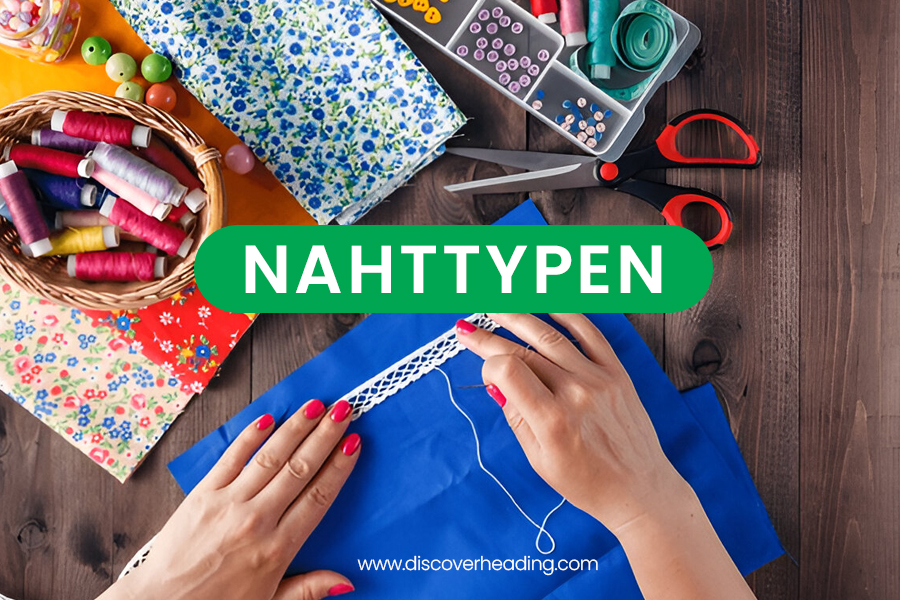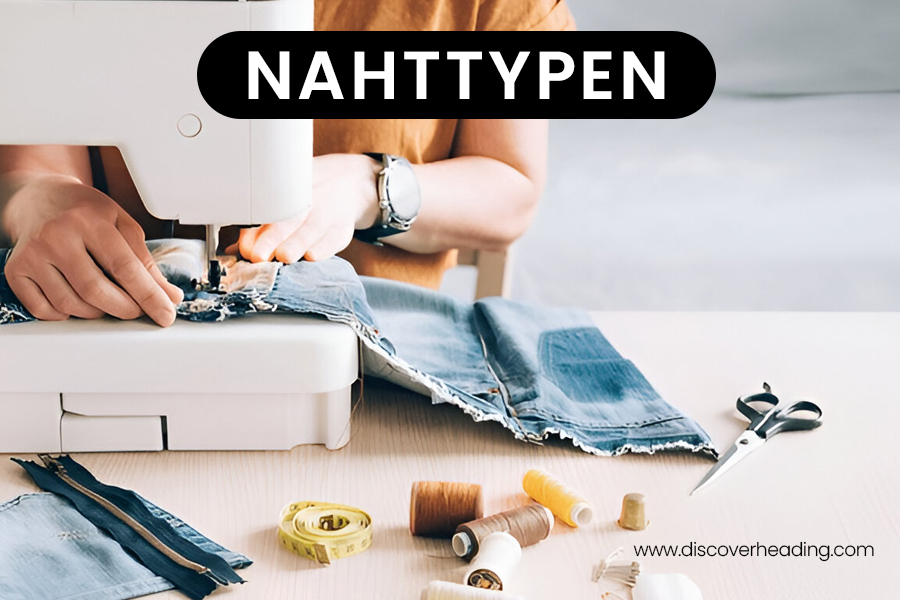Introduction to Nahttypen
If you’ve ever wondered what nahttypen means, here’s the quick answer: it refers to the different types of seams or stitching methods used in sewing and textiles. Whether you’re making a dress, upholstering a chair, or designing technical sportswear, choosing the right nahttypen can make the difference between a garment that falls apart after a few washes and one that lasts for years.
In this guide, we’ll go deep into what nahttypen are, the different types available, when to use each, and how they impact both the strength and style of your projects. We’ll also explore industrial applications, innovations, and practical sewing tips so you can confidently choose the right seam type for any fabric or design.
What Does Nahttypen Mean?
The German word nahttypen literally translates to “types of seams.” It covers everything from the simplest straight stitch to more complex, decorative, or reinforced seams used in fashion, upholstery, and industrial textiles.
Each seam type has its own purpose — some are meant to be hidden and functional, others are designed to be seen and enhance a garment’s visual appeal.
Why Understanding Seam Types is Important
Think of seams as the skeleton of your garment. Even if the fabric is high-quality, the wrong seam can ruin the fit, cause fraying, or make the clothing uncomfortable to wear. By knowing different nahttypen, you can:
- Improve garment durability
- Create more comfortable fits
- Achieve professional-level finishes
- Match style with function
A Brief History of Stitching and Seam Evolution
Seams have been around as long as humans have worn clothes. Early sewing techniques were hand-stitched using natural fibers like sinew or plant threads. As textiles evolved, so did seam types. The invention of the sewing machine in the 19th century brought new precision and speed, allowing tailors to experiment with different stitches for function and decoration.
Categories of Nahttypen
There are three main categories of seam types — basic, decorative, and functional. Let’s break them down.
Basic Seam Types
- Plain Seam
- French Seam
- Double-Stitched Seam
Decorative Seam Types
- Topstitch
- Piped Seam
- Flat-Felled Seam
Functional Seam Types
- Overlocked Seam
- Bound Seam
- Zigzag Seam
How Nahttypen Affect Fabric Durability
The right seam can make a garment last for years, while the wrong one can make it wear out in weeks.
- Strength Considerations
- Stretch and Flexibility
- Seam Longevity
Nahttypen in Fashion Design
- Aesthetic Appeal
- Balancing Functionality and Style
- Matching Seams to Fabric Types
Nahttypen in Industrial Applications
- Sportswear and Performance Gear
- Denim and Heavy-Duty Clothing
- Home Textiles and Upholstery
Bound and piped seams add both strength and decorative appeal.
Tools and Equipment for Different Nahttypen
- Sewing Machines
- Specialty Presser Feet
- Needles and Threads
1. Types of Sewing
- Hand Sewing
- The oldest sewing method, done entirely with a needle and thread.
- Great for delicate fabrics, repairs, and detailed finishing work.
- Machine Sewing
- Uses a sewing machine for faster, more consistent stitches.
- Ideal for garment construction, home décor, and mass production.
- Embroidery
- Decorative stitching to create patterns, monograms, or art on fabric.
- Can be done by hand or using specialized embroidery machines.
- Quilting
- Sewing together multiple layers (usually three) — a top fabric, batting, and backing.
- Popular for blankets, jackets, and decorative pieces.
- Tailoring
- Adjusting or constructing garments for a custom fit.
- Often involves advanced fitting, shaping, and finishing techniques.
- Upholstery Sewing
- Specialized sewing for furniture coverings, cushions, and car interiors.
- Requires heavy-duty machines and thick threads.
2. Types of Stitches
- Running Stitch
- Simple in-and-out stitch, often used for basting or gathering.
- Backstitch
- Strong hand stitch that locks each section, used for seams.
- Zigzag Stitch
- Machine stitch that prevents fabric edges from fraying.
- Overlock Stitch (Serger)
- Wraps thread around the fabric edge while trimming it.
- Blind Hem Stitch
- Almost invisible stitch for hemming skirts, pants, or curtains.
- Chain Stitch
- Looped stitch, decorative or functional, used in embroidery and vintage machines.
3. Types of Sewing Machines
- Mechanical Sewing Machines
- Operated manually with dials and levers.
- Reliable for basic sewing and repairs.
- Electronic Sewing Machines
- Uses buttons and electric settings for stitch types and adjustments.
- Offers more precision and ease.
- Computerized Sewing Machines
- Pre-programmed stitches, embroidery patterns, and automatic features.
- Great for advanced projects and speed.
- Serger/Overlock Machines
- Trims fabric edges and finishes them with a professional overlock stitch.
- Industrial Sewing Machines
- Built for high speed, heavy fabrics, and long-term production use.
- Embroidery Machines
- Specialized for creating decorative stitch designs automatically.
4. Types of Fabrics
- Woven Fabrics
- Threads interlaced at right angles (cotton, linen, denim).
Strong but can fray easily.
- Threads interlaced at right angles (cotton, linen, denim).
- Knit Fabrics
- Looped threads give stretch (jersey, rib knit, interlock).
Comfortable and flexible.
- Looped threads give stretch (jersey, rib knit, interlock).
- Nonwoven Fabrics
- Bonded fibers without weaving (felt, interfacing).
- Often used for structure or craft projects.
- Natural Fibers
- Plant-based (cotton, linen) or animal-based (wool, silk).
- Breathable and eco-friendly.
- Synthetic Fibers
- Man-made materials like polyester, nylon, spandex.
- Durable and often wrinkle-resistant.
- Blended Fabrics
- Mix of natural and synthetic fibers for balanced qualities.
Step-by-Step Guide to Sewing Common Nahttypen

- Preparing the Fabric – Pre-wash to prevent shrinkage, iron for accuracy.
- Aligning and Pinning – Keep fabric edges even.
- Sewing Techniques – Adjust stitch length and tension according to seam type.
Common Mistakes When Choosing Nahttypen
- Using a rigid seam on stretch fabric
- Skipping seam finishing on fray-prone fabrics
- Overcomplicating projects with unnecessary seam types
Maintenance and Repair of Seams
- Identifying Seam Wear
- Repair Techniques
- Preventive Measures
Innovations in Nahttypen
- Sustainable Sewing Practices – Using eco-friendly threads and minimal waste seams.
- Modern Sewing Machine Features – Built-in decorative stitches.
Smart Threads and Fabrics – Conductive seams for wearable tech.
Advanced Sewing Fundamentals
- Precision Cutting Techniques
Cutting is the foundation of sewing. Use a rotary cutter for straight edges, and cut on grain to ensure garments hang properly.
- Seam Finishes for Durability and Style
French seams hide raw edges, overlocking prevents fraying, and bound seams add luxury.
- Pattern Reading and Interpretation
Patterns are like blueprints—they tell you how your garment will come together. Understanding markings, notches, and grain lines is key.
Case Studies in Sewing Excellence
Case Study 1 – From Hobbyist to Etsy Success
Jane started sewing tote bags at her kitchen table. By perfecting her seams and photographing her work well, she turned a hobby into a thriving Etsy store.
Case Study 2 – How a Small Workshop Doubled Income with Quality Stitching
A small tailoring shop in London switched from quick repairs to bespoke garments. Word-of-mouth and online reviews doubled their revenue in six months.
Case Study 3 – Restoring Vintage Garments with Expert Sewing
A restoration specialist brought a 1920s flapper dress back to life by hand-reinforcing seams with silk thread—preserving history and gaining media attention.
Sewing Diagrams Explained in Words
Visualizing a French Seam Step-by-Step
Imagine sewing two pieces of fabric wrong sides together with a narrow seam, trimming the excess, then folding right sides together and stitching again to encase the raw edge—clean and strong.
Understanding Dart Construction Without Images
A dart is a triangle-shaped fold sewn into fabric to add shape. Fold along the dart line, match notches, and sew from the wide end to the point, tapering gradually.
Zipper Insertion Walkthrough
Place the zipper face-down on the fabric edge, baste it in place, sew close to the teeth with a zipper foot, then topstitch for a neat finish.
Deep Technical Sewing Details
The Science Behind Stitch Tension
Too tight and the fabric puckers; too loose and stitches unravel. Adjust tension until stitches lie flat on both sides.
When and How to Use Interfacing
Interfacing adds stability—use fusible for collars, waistbands, and button plackets; sew-in for delicate fabrics.
Tailoring Adjustments for Perfect Fit
Pin-fitting, muslin mockups, and strategic seam adjustments turn a good garment into a perfect one.
Common Mistakes and How to Avoid Them
Skipping Proper Pressing Techniques
Press every seam after sewing—it makes your garment look professional and helps it keep its shape.
Using the Wrong Needle for the Fabric
Ballpoint for knits, sharp for wovens, microtex for fine fabrics—wrong needle equals skipped stitches or fabric damage.
Ignoring Grain Lines in Cutting
Cutting off-grain twists garments out of shape, making them hang awkwardly.
Scaling Sewing Skills for Profit
Selling Handmade Products Online
Platforms like Etsy, Shopify, and even Instagram Shops can turn sewing into steady income.
Creating Sewing Courses or Workshops
Teach locally or online via Zoom—people will pay to learn specialized skills.
Building an SEO-Friendly Sewing Blog
Share tutorials, patterns, and troubleshooting tips to attract readers and potential customers.
Choosing the Right Nahttypen for Your Project
- Match to fabric weight and stretch
- Consider purpose and style
- Choose based on your skill level
Nahttypen Glossary – Quick Reference
- Plain Seam – Basic joining method
- French Seam – Encloses raw edges
- Overlocked Seam – Prevents fraying
Conclusion – Mastering Nahttypen for Better Sewing Projects
By understanding nahttypen, you unlock the ability to create garments and textiles that not only look beautiful but last longer. Whether you’re sewing by hand, working with a machine, or designing for industrial production, the right seam choice blends durability, comfort, and style.
FAQs
1. What are the most durable nahttypen?
Flat-felled seams and double-stitched seams are among the strongest.
2. Which nahttypen is best for beginners?
A plain seam is easiest to start with.
3. How do I choose the right seam for stretch fabrics?
Use zigzag or overlocked seams to allow flexibility.
4. Can I mix different nahttypen in one garment?
Yes, but ensure they complement each other in strength and style.
5. What is the difference between decorative and functional seams?
Decorative seams enhance appearance; functional seams focus on durability and structure.
Don’t miss out on any news—keep in touch for real-time information visit: Discover Heading!

